Field Division
WARNING: Do not cite this page as a reference. This page is on this wiki only to make the content "searchable" and easier to find. If you find the information you seek here, go to the original sources as linked below to verify the information and use them for your documentation.
Glossary of Terms: Partition[edit | edit source]
A division of the field into pieces that have different tinctures. Some partitions follow and are named after ordinaries, like per pale, per fess, per bend, and per saltire; others have their own names, like checky, lozengy, and quarterly.
See also : Divisions and Ordinaries, Complex Lines of Division, Complex Lines from the old Heraldic Primer, Triangular Divisions and Charges
Examples:[edit | edit source]
Period:[edit | edit source]
Barry invected, barry indented[edit | edit source]
| c.1558 | 1506-1509 |
| c.1558 Universeel Wapenboek, KM1063, barry invected | 1506-1509 Livro do Armeiro-Mor, 134v, barry indented and a huge canton |
Bendy:[edit | edit source]
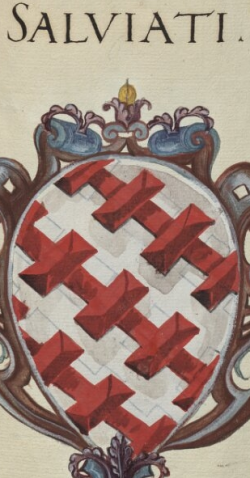
|
|
| Insignia Florentinorum BSB277, f124r, Salviati, bendy bretessed |
Checky[edit | edit source]
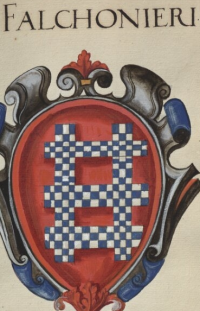
|
Checky |
| Insignia Florentinorum, BSB 277, f64r, checky thing | Checky with a monkey crest |
Quarterly, per saltire[edit | edit source]
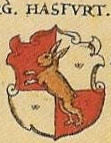
|
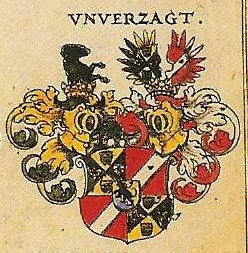
|
| Siebmacher's Wappenbuch, 1605, plate 225, quarterly, rabbit | Siebmacher, 1605, plate 33, Unverzagt, per saltire with four charges. FB image courtesy of Bruce Draconarius. Siebmacher, 1605, plate 33, Unverzagt, per saltire with four charges. FB image courtesy of Bruce Draconarius. "Per saltire Or and sable, in pale two lion's faces sable and in fess two fleurs-de-lys argent." |
An Ordinary of Siebmacher's Wappenbuch, see the "Field, Divided" links:[edit | edit source]
Modern:[edit | edit source]
Pictorial Dictionary, 3rd edition:[edit | edit source]
Vector Graphics:[edit | edit source]
Book of Traceable Heraldic Art
Pennsic Traceable Art Project:
Heraldic Primer (old version):[edit | edit source]
New version is at http://heraldry.sca.org/armory/newprimer/h4f5.shtml
The field may be divided into multiple sections in certain conventional ways. The field is still considered to be a single layer, so no section is considered to be "on" any other. In general the sections of a divided field are blazoned in the order that one would read a page: primarily from top to bottom and secondarily from left to right, as one faces the shield.
Two-part Field Divisions[edit | edit source]
| Per bend sable and argent. | Per bend sinister sable and argent]. | Per chevron sable and argent. | Per chevron inverted sable and argent. |

|

|

|

|
| Per fess sable and argent. | Per pale sable and argent. | ||

|

|
Three-part Field Divisions[edit | edit source]
Note that "per pall" and "per pall inverted" should divide the field evenly into three parts.
| Per pall sable, argent, and gules. | Per pall inverted sable, argent, and gules. |
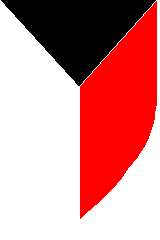
|
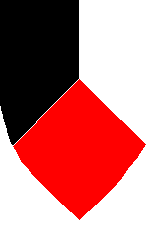
|
Four-part Field Divisions[edit | edit source]
| Per saltire sable and argent. | Quarterly sable and argent. |
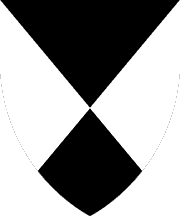
|
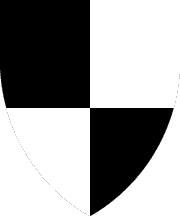
|
Eight-part Field Division[edit | edit source]
| Gyronny sable and argent. |
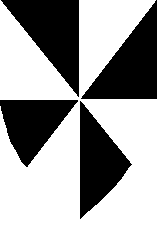
|
Many-part Field Divisions[edit | edit source]
With these divisions, the number of parts is usually an unspecified even number greater than four.
| Paly sable and argent. | Barry sable and argent. | Bendy argent and sable. | Bendy sinister sable and argent. |
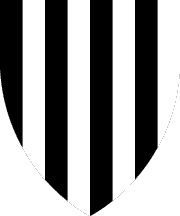
|
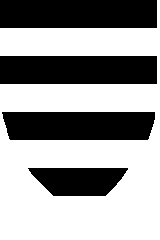
|
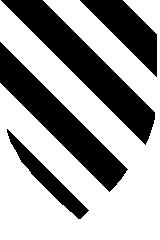
|
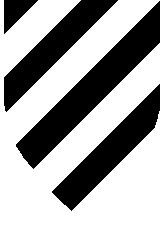
|
| Chequy sable and argent. | Lozengy argent and sable. | Pily sable and argent. | |
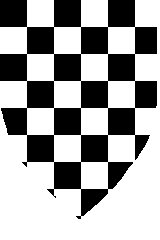
|
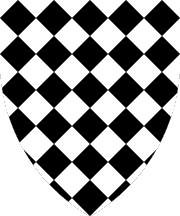
|
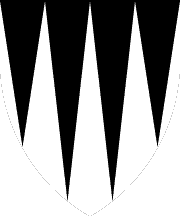
|
SENA A.5.F.1. and A.5.F.2 - Standards for Difference through a Single Substantial Change of Field for Fielded Armory[edit | edit source]
As of 2021
1. Substantial Change of Partition: A new submission is clear of any other piece of protected armory when it substantially changes the partitioning of the field. [updated 3/2021]
- a. Total Addition or Removal of Division: Any divided field has a substantially changed partition from any plain field. The multiply divided furs are considered plain fields for this purpose. [updated 3/2021]
- For example, Per pale azure and vert is substantially different from Vert, and thus clear of conflict with it. It would also be substantially different from Vair or Potent.
- b. Substantial Change of Direction of Division: A change in direction of the lines of partition creates a substantial change of partition. Most of the standard lines of division are substantially different. Any field division which differs only by the number of partitions in a single direction is not substantially different. The pairs per bend and bendy, per bend sinister and bendy sinister, per chevron and chevronelly, per fess and barry, and per pale and paly are not substantially different from the other half of their pair. Each of the above mentioned divisions is otherwise substantially different from all other divisions. Therefore, the pairs chevronelly and paly, 'per bend and per bend sinister, etc., are substantially different.
- For example, Per pale argent and gules is substantially different from Per fess argent and gules and from Per chevron argent and gules... However, Per pale argent and gules is not substantially different from Paly argent and gules.
- Per pall, and per pall inverted are clear of all other divisions.
- Quarterly and per saltire are substantially different from all two-part divisions and three-part divisions. They are also substantially different from all other four-part divisions (such as per pale and per chevron or per bend and per fess). The other four-part divisions are only substantially different from one another if they share no lines of division in common. All four-part divisions are substantially different from divisions that split the field evenly into more than four partitions.
- For example, per pale and per chevron is substantially difference from per fess and per bend sinister, as they have no lines of division in common. Checky is substantially different from all other fields. While checky is substantially different from all other grid-like partitions (i.e., those formed by two sets of parallel lines, such as lozengy and barry-bendy); these other grid-like partitions are not substantially different from one another. This is because they all create a general impression of lozenges of some sort. These grid-like partitions are all substantially different from partitions that split the field into six or fewer partitions.
- For example, Barry and per pale argent and vert is substantially different from Checky argent and vert, but is not clear of conflict under this rule from Bendy and per pale argent and vert.
>> Gyronny (of any number of pieces) and party of six are substantially different form all other partions. Other multiply parted divisions (bendy, barry, etc., are discussed in the first paragraph of this section.
- Lines of division not mentioned here explicitly may be determined to be substantially different on a case by case basis.
- As a reference, these categories are all substantially different from each other:
- per pale, paly
- per fess, barry
- per bend, bendy
- per bend sinister, bendy sinister
- per chevron, chevronelly
- per chevron inverted, chevronelly inverted
- gyronny (any number of pieces)
- per pall
- per pall inverted
- per saltire
- quarterly
- other divisions into four equal parts(may have substantial difference between themselves, if they share no lines in common, such as per pale and per chevron compared to per fess and per bend sinister)
- party of six
- checky
- lozengy and all other grid-like partitions (such as barry bendy and per pale and chevronelly
- 2. Substantial Change of Tincture: If the field of a new field-primary submission has no tinctures in common with the field of a protected piece of armory, they do not conflict. If a new submission with a field divided into two sections, three sections, quarterly, or per saltire has changed the tincture of each section of that field and each has at least one tincture on the field that the other does not, the two are substantially different and do not conflict.
Furs are considered to be different from one another and from their base tincture. The addition of a field treatment is also a change of tincture. For example, Per chevron azure and gules and Per chevron sable and argent do not conflict, because the fields do not share a tincture. Per pale azure and gules and Per pale gules and argent do not conflict, because they are a type of field division with two sections, they have changed the tincture of each section, and each one has a tincture that differs. Similarly, Quarterly azure and gules, a bordure argent and Quarterly gules and Or a bordure argent do not conflict because they are four-section field divisions, they have changed the tincture of each section, and they each have a tincture that differs - the tincture of the bordure is not relevant. In contrast, Per pale azure and gules is not clear of conflict under this rule with Per pale gules and azure because neither has a tincture the other does not. Barry bendy vert and argent is not clear of conflict under this rule with Barry bendy sinister vert and Or because both share a tincture in the same section. Paly azure and gules is not clear of conflict under this rule with Paly gules and argent because they are divided into multiple sections (such that the order of the tinctures makes little visual difference) and they share a tincture. This is true even for Paly of four parts. Per bend ermine and azure is substantially different from Per bend erminois and gules and from Per bend argent and sable. Per fess argent and gules is substantially different from Per fess argent masoned gules and sable. In each case, the two pieces of armory have no tinctures in common.
SENA A.5.G.1.[edit | edit source]
As of 3/2021
1. Changes to the Field: Distinctly changing the tinctures, direction of partition lines, style of partition lines, or number of pieces in a partition of the field is one distinct change (DC). [updated 3/2021]
Armory can be cleared of conflict by a single substantial change to the field as described in A.5.F above, through two distinct changes under this rule, or through two distinct changes under any combination of rules in A.5.G, including changes to peripheral ordinaries and tertiary charges on them.
For example, Per chevron argent and azure, a lion gules does not conflict with Chevronelly argent and sable, a lion gules; there is a DC for changing at least half the tincture of the field (A5G1a), and a DC for changing the number of pieces of the field (A5G1d). For example, Per pale indented argent and azure, a lion gules does not conflict with Per fess argent and azure, a lion gules; there is a DC for changing the direction of the partition lines (A5G1b), and a DC for changing the style of the partition lines (A5G1c). For example, Per pale azure and argent, a lion gules has one DC from Per pale azure and bendy argent and sable, a lion gules (A5G1d), but does not receive a DC for the difference in tincture (A5G1a) as it is less than half of the field.
- a. Change of Tincture: If the tincture of at least half the field is changed, the fields will be considered different enough to be a distinct change (DC). There is a distinct change for swapping or rotating the tinctures of a field evenly divided into two, three, or four parts. There is not a distinct change for swapping the tinctures of a field divided into more than four parts. Furs and fields with field treatments are considered different tinctures from their underlying tincture and from other variants which share an underlying tincture.
- For example, each of the following has one DC from the other two: Argent, a tree vert, Ermine, a tree vert and Argent masoned sable, a tree vert. In each case, the field tincture is distinctly changed. Per pall sable, gules, and argent has one DC from both Per pall azure, gules, and Or and Per pall gules, argent, and sable. In each case at least half of the field tincture has been changed.
- For example, Quarterly argent and azure, a lucy gules has one DC from Quarterly azure and argent, a lucy gules. However, Checky argent and azure, a lucy gules does not have a DC from Checky azure and argent, a lucy gules.
- b. Change of Direction of Partition Lines: A change of direction of partition lines creates a distinct change (DC). The major single partition lines include: per bend, per bend sinister, per pale, per fess, per chevron, and per chevron inverted; a change from one to another (whether as single lines or multiple forms) is a distinct change. In addition, a change from any of these to per saltire, quarterly, gyronny (of any number of pieces), per pall, and per pall inverted, checky, and lozengy or a change between any of these is considered a distinct change. A change in direction of half the lines of a design gives a distinct change. In general, the addition, removal, or change of a partition line or group of partition lines that changes the organization of tinctures in ways that affect at least half the field will be considered a distinct change.
- For example, Per bend vair and gules is a DC from Per pale vair and gules. For example, Barry bendy sable and Or is a DC from Paly bendy sable and Or. For example, Barry wavy azure and argent is a DC from Per pale and barry wavy azure and argent.
- c. Change of Style of Partition Lines: All partition lines have a style, either plain (straight) or complex. A change of style of half the partition lines is a distinct change (DC). The types of complex lines which are distinctly different are discussed in Appendix M.
- For example, Per pale is a DC from Per pale embattled. For example, Barry wavy is a DC from Barry engrailed and from Barry (plain). For example, Quarterly is a DC from Quarterly per fess indented.
- d. Change of Number of Pieces: Changing the number of pieces into which the field is divided is a distinct change (DC). When considering the field as a whole, a field with one, two, three, or four pieces has a distinct change from armory with any other number, but above that there is no distinct change. When considering changes to only half of an already divided field, a half with one, two, or three pieces can have a distinct change from armory with a half of any other number of pieces, but any number beyond that is considered the same.
- For example, Per chevron gules and argent, a pale azure has one DC from Chevronelly gules and argent, a pale azure. Quarterly Or and sable, a fleur-de-lys gules has one DC from Checky Or and sable, a fleur-de-lys gules. Per pale azure and argent has one DC from /er pale azure and bendy argent and gules. In each case, the change of number of pieces is significant.
- For example, Gyronny of six ermine and vert, a roundel sable does not have a DC from Gyronny (of eight) ermine and vert, a roundel sable. There is no DC between Barry wavy of six argent and azure, a dolphin gules and the same design drawn with more traits, and we generally do not blazon that difference.
- The one exception is party of six, which is divided in a different pattern (effectively per fess and paly of three) and was seen as a distinct field division in period. Therefore, it has one DC from checky and designs that create large numbers of lozenges (such as paly bendy). However, it does not have a DC from designs such as Paly and per fess which create the same overall impression.
- e. omitted (re. fieldless armory)
http://heraldry.sca.org/laurel/sena.html#A5G
SENA Appendix H: Low-Contrast Complex Lines of Division[edit | edit source]
as of 6/2022
The primary standard for low-contrast complex lines of division is that they be readily identifiable.
In many cases, a charge overlying a low-contrast complex line of division will render the line of division unidentifiable. Thus, divided fields with low-contrast tinctures with complex lines of division will be registered with a charge overlying the line division only if the line of division remains readily identifiable.
In some cases, even if there is no overlying charge, a low-contrast complex line of division may be unidentifiable and thus unregisterable. Similarly, in some cases, the specific shades used in a submission may render a low-contrast complex line of division unidentifiable and thus unregisterable, even if the combination has previously been registered.
Some low-contrast complex line combinations which have been registered recently are:
- argent and Or: with a right step
- azure and gules: embattled
- azure and vert: embattled
- gules and sable: arrondi; indented; rayonny
- gules and purpure: indented
- gules and vert: enarched
- purpure and vert: wavy
- sable and vert: dovetailed; indented
Some low-contrast complex line combinations which have been ruled unregisterable, even when there is no overlying charge, are:
- sable and purpure
- sable and azure
http://heraldry.sca.org/sena.html#AppendixH
Precedents:[edit | edit source]
Precedents of the SCA College of Arms - http://heraldry.sca.org/laurel/precedents.html
>Morsulus Heralds Website - http://www.morsulus.org/]] (to search the LoARs and Precedents)
Restatement Wiki - http://yehudaheraldry.com/restatement/index.php?title=Main_Page]] (restatements of Precedents)
Use the above links to be sure any precedents listed below haven't been superseded by newer precedents.
Definition/Defining Instance:[edit | edit source]
Registerability:[edit | edit source]
(Restricted, Reserved, SFPP, OOP)
Conflict:[edit | edit source]
March 2021 CL - substantial difference for field changes not just for field-primary:[edit | edit source]
From Wreath: Change to SENA A5F
The December 23rd Rules Letter proposed changes to SENA A5F to allow a substantial difference for changes to the field for all fielded armory, not just field-primary armory. Those suggestions, with some modifications are accepted. [See A.5.F for the revised wording.]
https://heraldry.sca.org/loar/2021/03/21-03cl.html
March 2021 CL - multiple DCs for field changes not just for field-primary:[edit | edit source]
From Wreath: Change to SENA A5G1 The December 23rd Rules Letter proposed changes to SENA A5G1 to allow all fielded armory to receive multiple DCs for changes to the field which previously only applied to field-primary armory. Those changes are accepted. [See A.5.G for the revised wording.]
https://heraldry.sca.org/loar/2021/03/21-03cl.html
September 2008 - lozenge throughout vs. vetu, plain vs. ploye:[edit | edit source]
Elspeth Jamieson. Device. Argent vêtu ployé azure, two serpents erect respectant entwined sable. This is returned for conflict with Werenher von Ingolstadt, Azure, on a lozenge argent, a bear statant erect sable. Precedent, set in April 2008, says "While a lozenge throughout must always be checked as though it were a vêtu field (and thus comparable to all other fields), a lozenge need only be compared to a vêtu field (not to all fields)." The converse is not true - vêtu must be checked against a lozenge throughout, a lozenge, and all fields. Since Elspeth's submission can be blazoned as Azure, on a lozenge ployé throughout argent, two serpents erect respectant, bodies entwined sable, there is only a single CD for the multiple changes to the tertiary charges. We do not give a CD for the difference between a lozenge and a lozenge throughout, nor do we give one for the difference between plain and ployé edges on a charge.
November 2001 - chevrons vs. chevronelly, etc.:[edit | edit source]
Torfin de Carric. Device. Chevronelly Or and gules.
- Conflict with Clare, Earl of Gloucester, Or three chevrons gules (Important non-SCA armory). There is no difference between chevronelly and multiple chevronels.
- Past precedent indicates that no difference should be given for paly versus pallets, or barry versus bars, due to their historical interchangeability. This interchangeability has been extended for SCA practice to bendlets sinister:
- [considering Argent, four scarpes gules, overall a bear rampant sable//] After much thought we have decided that with that many scarpes on the field, that there is no effective difference between that and a bendy sinister field. It was not unusual for barry or paly fields in period to be drawn with an odd number of traits (which we'd blazon as bars or palets); see, for example, the arms of Mouton (Multon, Moleton) found both as //Barry argent and gules// and //Argent, three bars gules//. (Dictionary of British Arms, Volume 1, pp 59, 88; Foster, p.145) and the arms of von Rosenberg, whose Per fess field has in base either three bends or bendy depending upon the artist's whim (Siebmacher, p. 8; Neubecker and Rentzmann, p. 290). Even when the distinction is worth blazoning, it's worth no difference. Therefore, this conflicts with ... //Argent, a bear rampant sable.... (Aron Niedþwiedþ, 12/97 LoAR p. 8)
- The situation with chevronelly is more ambiguous, both historically and visually. Electrum has provided evidence that strongly implies that chevronelly and multiple chevrons were drawn interchangeably before 1300, but by 1400 depictions of arms using three chevrons would consistently have been drawn as we would expect three chevrons to be drawn. However, no one has provided evidence suggesting that chevronelly and multiple chevrons would have been considered different by a later period viewer: chevronelly might have been considered a poor artistic rendering of three chevrons, rather than a distinct cadenced, or completely different, coat.
- Visually, chevronelly may at times differ from being exactly analogous to barry, paly and bendy. In the latter fields, the only way to visually distinguish these designs from bars, pallets or bendlets is to count the stripes or compare the tincture of the top and bottom stripe. The majority of the shield looks just the same regardless of whether there are an odd or even number of traits. In the case of chevronelly versus chevronels, there can be an extra visual cue that chevronelly is intended. In arms such as Or three chevronels gules//, the point of the chiefmost gules chevron would always be clearly visible as a point, and not cut off at the top of the shield. //Chevronelly Or and gules could be drawn with the top of the gules chevron cut off at the top of the shield, giving a clear visual cue that chevronelly is intended, and not requiring the counting of traits or looking at the tincture of the bottom trait.
- However, this visual cue is not present in all depictions of chevronelly. Chevronelly may be drawn in such a way as to require counting of traits, or looking at the bottom trait of the shield, to determine which design is intended. This would be the depiction where the top gules chevron has a visual point: it's throughout (touching the chief), which would be a reasonable depiction for the top of a shield showing Or three chevronels gules. The emblazon of this submission is drawn in such a way, with the top gules chevron portion being throughout.
- Given the well established pattern of interchangeability for other multiply divided fields versus multiple ordinaries, and the ambiguities in the case of chevronelly versus chevronels, it seems appropriate to extend the ruling for the other ordinaries to cover chevrons.
http://heraldry.sca.org/loar/2001/11/01-11lar.html
Identifiability:[edit | edit source]
Collected Precedents:[edit | edit source]
- 2nd Tenure of Elisabeth de Rossignol (April 2011 - August 2011) - Collected Armory Precedents
- 1st Tenure of Elisabeth de Rossignol (May 2005 - July 2008) - FIELD DIVISION -- Barry, FIELD DIVISION -- Checky, FIELD DIVISION -- Gyronny, FIELD DIVISION -- Miscellaneous, FIELD DIVISION -- Per Bend and Per Bend Sinister, FIELD DIVISION -- Per Chevron, FIELD DIVISION -- Per Fess, FIELD DIVISION -- Per Pale, FIELD DIVISION -- Per Saltire, FIELD DIVISION -- Vetú
- The 2nd Tenure of François la Flamme (October 2004 - May 2005) - FIELD DIVISION -- Barry, FIELD DIVISION -- Chapé and Chaussé, FIELD DIVISION -- Checky and Party of Six, FIELD DIVISION -- Gyronny, FIELD DIVISION -- Miscellaneous, FIELD DIVISION -- Per Chevron and Per Chevron Inverted, FIELD DIVISION -- Per Fess, [http:www.ellipsis.cx/~liana/sca/armoryprec.html#FIELDQuarterly FIELD DIVISION -- Quarterly]
- The Tenure of Shauna of Carrick Point (May 2004 - August 2004) - Collected Armory Precedents
- The Tenure of François la Flamme (August 2001 - April 2004) - Collected Armory Precedents
- The Tenure of Elsbeth Anne Roth (June 1999 - July 2001) - Collected Armory Precedents
- The Tenure of Jaelle of Armida (June 1996 - June 1999) - Single HTML Document
- 2nd Tenure of Da'ud ibn Auda (November 1993 - June 1996) -
- the 1st part (Nov 1993 - June 1994) and
- the 2nd part (July 1994 - June 1996)* The Tenure of Bruce Draconarius of Mistholme (June 1992 - October 1993) - Collected precedents
- 1st Tenure of Da'ud ibn Auda (June 1990 - June 1992) -
- The Tenure of Alisoun MacCoul of Elphane (September 1986 - June 1990) - Barry
- The Tenure of Baldwin of Erebor (August 1984 - August 1986) - Single HTML Document
- The Tenure of Wilhelm von Schlüssel (August 1979 - August 1984) - BARRULY, BARRY
- The Tenure of Karina of the Far West (December 1975 - June 1979) - Collected Precedents
- The Early Days (June 1971 - June 1975) - http://heraldry.sca.org/precedents/early/atoc.html#barruly BARRULY], BARRY
Ordinary[edit | edit source]
- Field division - Barruly - see Field division - Barry]
- Field division - Barry - Plain line - Argent]
- Field division - Barry - Plain line - Azure]
- Field division - Barry - Plain line - Fur]
- Field division - Barry - Plain line - Gules]
- Field division - Barry - Plain line - Multicolor]
- Field division - Barry - Plain line - Or]
- Field division - Barry - Plain line - Purpure]
- Field division - Barry - Plain line - Sable]
- Field division - Barry - Complex line - Argent]
- Field division - Barry - Complex line - Azure]
- Field division - Barry - Complex line - Fur]
- Field division - Barry - Complex line - Gules]
- Field division - Barry - Complex line - Multicolor]
- Field division - Barry - Complex line - Or]
- Field division - Barry - Complex line - Purpure]
- Field division - Barry - Complex line - Sable]
- Field division - Bendy] - see also Bend] * Field division - Bendy sinister] - see also Bend sinister]
- Field division - Chape - see Pile inverted] and Field division - Per chevron]
- Field division - Chausse - see Pile] and Field division - Per chevron inverted]
- Field division - Checky - Argent - and azure]
- Field division - Checky - Argent - and fur]
- Field division - Checky - Argent - and gules]
- Field division - Checky - Argent - and multicolor]
- Field division - Checky - Argent - and or]
- Field division - Checky - Argent - and purpure]
- Field division - Checky - Argent - and sable]
- Field division - Checky - Argent - and vert]
- Field division - Checky - Azure - and fur]
- Field division - Checky - Azure - and gules]
- Field division - Checky - Azure - and multicolor]
- Field division - Checky - Azure - and or]
- Field division - Checky - Azure - and purpure]
- Field division - Checky - Azure - and sable]
- Field division - Checky - Azure - and vert]
- Field division - Checky - Fur - and fur]
- Field division - Checky - Fur - and gules]
- Field division - Checky - Fur - and multicolor]
- Field division - Checky - Fur - and or]
- Field division - Checky - Fur - and purpure]
- Field division - Checky - Fur - and sable]
- Field division - Checky - Fur - and vert]
- Field division - Checky - Gules - and multicolor]
- Field division - Checky - Gules - and or]
- Field division - Checky - Gules - and purpure]
- Field division - Checky - Gules - and sable]
- Field division - Checky - Gules - and vert]
- Field division - Checky - Multicolor - and multicolor]
- Field division - Checky - Multicolor - and or]
- Field division - Checky - Multicolor - and purpure]
- Field division - Checky - Multicolor - and sable]
- Field division - Checky - Multicolor - and vert]
- Field division - Checky - Or - and purpure]
- Field division - Checky - Or - and sable]
- Field division - Checky - Or - and vert]
- Field division - Checky - Purpure - and sable]
- Field division - Checky - Purpure - and vert]
- Field division - Checky - Sable - and vert]
- Field division - Chequy - see [Field division - Checky
- Field division - Chevronelly] - see also Chevron]
- Field division - Fusilly - see Field division - Lozengy
- Field division - Gurgity - see Gurges
- Field division - Gyronny - Argent - and azure]
- Field division - Gyronny - Argent - and fur]
- Field division - Gyronny - Argent - and gules]
- Field division - Gyronny - Argent - and multicolor]
- Field division - Gyronny - Argent - and or]
- Field division - Gyronny - Argent - and purpure]
- Field division - Gyronny - Argent - and sable]
- Field division - Gyronny - Argent - and vert]
- Field division - Gyronny - Azure - and fur]
- Field division - Gyronny - Azure - and gules]
- Field division - Gyronny - Azure - and multicolor]
- Field division - Gyronny - Azure - and or]
- Field division - Gyronny - Azure - and purpure]
- Field division - Gyronny - Azure - and sable]
- Field division - Gyronny - Azure - and vert]
- Field division - Gyronny - Fur - and fur]
- Field division - Gyronny - Fur - and gules]
- Field division - Gyronny - Fur - and multicolor]
- Field division - Gyronny - Fur - and or]
- Field division - Gyronny - Fur - and purpure]
- Field division - Gyronny - Fur - and sable]
- Field division - Gyronny - Fur - and vert]
- Field division - Gyronny - Gules - and multicolor]
- Field division - Gyronny - Gules - and or]
- Field division - Gyronny - Gules - and purpure]
- Field division - Gyronny - Gules - and sable]
- Field division - Gyronny - Gules - and vert]
- Field division - Gyronny - Multicolor - and multicolor]
- Field division - Gyronny - Multicolor - and or]
- Field division - Gyronny - Multicolor - and purpure]
- Field division - Gyronny - Multicolor - and sable]
- Field division - Gyronny - Multicolor - and vert]
- Field division - Gyronny - Or - and purpure]
- Field division - Gyronny - Or - and sable]
- Field division - Gyronny - Or - and vert]
- Field division - Gyronny - Purpure - and sable]
- Field division - Gyronny - Purpure - and vert]
- Field division - Gyronny - Sable - and vert]
- Field division - Lozengy] (includes fusilly)
- Field division - Paly - see also Pale
- Field division - Per bend - Argent - and azure]
- Field division - Per bend - Argent - and fur]
- Field division - Per bend - Argent - and gules]
- Field division - Per bend - Argent - and multicolor]
- Field division - Per bend - Argent - and or]
- Field division - Per bend - Argent - and purpure]
- Field division - Per bend - Argent - and sable]
- Field division - Per bend - Argent - and vert]
- Field division - Per bend - Azure - and argent]
- Field division - Per bend - Azure - and fur]
- Field division - Per bend - Azure - and gules]
- Field division - Per bend - Azure - and multicolor]
- Field division - Per bend - Azure - and or]
- Field division - Per bend - Azure - and purpure]
- Field division - Per bend - Azure - and sable]
- Field division - Per bend - Azure - and vert]
- Field division - Per bend - Fur]
- Field division - Per bend - Gules - and argent]
- Field division - Per bend - Gules - and azure]
- Field division - Per bend - Gules - and fur]
- Field division - Per bend - Gules - and multicolor]
- Field division - Per bend - Gules - and or]
- Field division - Per bend - Gules - and purpure]
- Field division - Per bend - Gules - and sable]
- Field division - Per bend - Gules - and vert]
- Field division - Per bend - Multicolor]
- Field division - Per bend - Or - and argent]
- Field division - Per bend - Or - and azure]
- Field division - Per bend - Or - and fur]
- Field division - Per bend - Or - and gules]
- Field division - Per bend - Or - and multicolor]
- Field division - Per bend - Or - and purpure]
- Field division - Per bend - Or - and sable]
- Field division - Per bend - Or - and vert]
- Field division - Per bend - Purpure - and argent]
- Field division - Per bend - Purpure - and azure]
- Field division - Per bend - Purpure - and fur]
- Field division - Per bend - Purpure - and gules]
- Field division - Per bend - Purpure - and multicolor]
- Field division - Per bend - Purpure - and or]
- Field division - Per bend - Purpure - and sable]
- Field division - Per bend - Purpure - and vert]
- Field division - Per bend - Sable - and argent]
- Field division - Per bend - Sable - and azure]
- Field division - Per bend - Sable - and fur]
- Field division - Per bend - Sable - and gules]
- Field division - Per bend - Sable - and multicolor]
- Field division - Per bend - Sable - and or]
- Field division - Per bend - Sable - and purpure]
- Field division - Per bend - Sable - and vert]
- Field division - Per bend - Vert - and argent]
- Field division - Per bend - Vert - and azure]
- Field division - Per bend - Vert - and fur]
- Field division - Per bend - Vert - and gules]
- Field division - Per bend - Vert - and multicolor]
- Field division - Per bend - Vert - and or]
- Field division - Per bend - Vert - and purpure]
- Field division - Per bend - Vert - and sable] #fielddivisionperbendsinister
- Field division - Per bend sinister - Argent - and azure]
- Field division - Per bend sinister - Argent - and fur]
- Field division - Per bend sinister - Argent - and gules]
- Field division - Per bend sinister - Argent - and multicolor]
- Field division - Per bend sinister - Argent - and or]
- Field division - Per bend sinister - Argent - and purpure]
- Field division - Per bend sinister - Argent - and sable]
- Field division - Per bend sinister - Argent - and vert]
- Field division - Per bend sinister - Azure - and argent]
- Field division - Per bend sinister - Azure - and fur]
- Field division - Per bend sinister - Azure - and gules]
- Field division - Per bend sinister - Azure - and multicolor]
- Field division - Per bend sinister - Azure - and or]
- Field division - Per bend sinister - Azure - and purpure]
- Field division - Per bend sinister - Azure - and sable]
- Field division - Per bend sinister - Azure - and vert]
- Field division - Per bend sinister - Fur]
- Field division - Per bend sinister - Gules - and argent]
- Field division - Per bend sinister - Gules - and azure]
- Field division - Per bend sinister - Gules - and fur]
- Field division - Per bend sinister - Gules - and multicolor]
- Field division - Per bend sinister - Gules - and or]
- Field division - Per bend sinister - Gules - and purpure]
- Field division - Per bend sinister - Gules - and sable]
- Field division - Per bend sinister - Gules - and vert]
- Field division - Per bend sinister - Multicolor]
- Field division - Per bend sinister - Or - and argent]
- Field division - Per bend sinister - Or - and azure]
- Field division - Per bend sinister - Or - and fur]
- Field division - Per bend sinister - Or - and gules]
- Field division - Per bend sinister - Or - and multicolor]
- Field division - Per bend sinister - Or - and purpure]
- Field division - Per bend sinister - Or - and sable]
- Field division - Per bend sinister - Or - and vert]
- Field division - Per bend sinister - Purpure - and argent]
- Field division - Per bend sinister - Purpure - and azure]
- Field division - Per bend sinister - Purpure - and fur]
- Field division - Per bend sinister - Purpure - and gules]
- Field division - Per bend sinister - Purpure - and multicolor]
- Field division - Per bend sinister - Purpure - and or]
- Field division - Per bend sinister - Purpure - and sable]
- Field division - Per bend sinister - Purpure - and vert]
- Field division - Per bend sinister - Sable - and argent]
- Field division - Per bend sinister - Sable - and azure]
- Field division - Per bend sinister - Sable - and fur]
- Field division - Per bend sinister - Sable - and gules]
- Field division - Per bend sinister - Sable - and multicolor]
- Field division - Per bend sinister - Sable - and or]
- Field division - Per bend sinister - Sable - and purpure]
- Field division - Per bend sinister - Sable - and vert]
- Field division - Per bend sinister - Vert - and argent]
- Field division - Per bend sinister - Vert - and azure]
- Field division - Per bend sinister - Vert - and fur]
- Field division - Per bend sinister - Vert - and gules]
- Field division - Per bend sinister - Vert - and multicolor]
- Field division - Per bend sinister - Vert - and or]
- Field division - Per bend sinister - Vert - and purpure]
- Field division - Per bend sinister - Vert - and sable]
- Field division - Per chevron - Argent - and azure]
- Field division - Per chevron - Argent - and fur]
- Field division - Per chevron - Argent - and gules]
- Field division - Per chevron - Argent - and multicolor]
- Field division - Per chevron - Argent - and or]
- Field division - Per chevron - Argent - and purpure]
- Field division - Per chevron - Argent - and sable]
- Field division - Per chevron - Argent - and vert]
- Field division - Per chevron - Azure - and argent]
- Field division - Per chevron - Azure - and fur]
- Field division - Per chevron - Azure - and gules]
- Field division - Per chevron - Azure - and multicolor]
- Field division - Per chevron - Azure - and or]
- Field division - Per chevron - Azure - and purpure]
- Field division - Per chevron - Azure - and sable]
- Field division - Per chevron - Azure - and vert]
- Field division - Per chevron - Fur]
- Field division - Per chevron - Gules - and argent]
- Field division - Per chevron - Gules - and azure]
- Field division - Per chevron - Gules - and fur]
- Field division - Per chevron - Gules - and multicolor]
- Field division - Per chevron - Gules - and or]
- Field division - Per chevron - Gules - and purpure]
- Field division - Per chevron - Gules - and sable]
- Field division - Per chevron - Gules - and vert]
- Field division - Per chevron - Multicolor]
- Field division - Per chevron - Or - and argent]
- Field division - Per chevron - Or - and azure]
- Field division - Per chevron - Or - and fur]
- Field division - Per chevron - Or - and gules]
- Field division - Per chevron - Or - and multicolor]
- Field division - Per chevron - Or - and purpure]
- Field division - Per chevron - Or - and sable]
- Field division - Per chevron - Or - and vert]
- Field division - Per chevron - Purpure - and argent]
- Field division - Per chevron - Purpure - and azure]
- Field division - Per chevron - Purpure - and fur]
- Field division - Per chevron - Purpure - and gules]
- Field division - Per chevron - Purpure - and multicolor]
- Field division - Per chevron - Purpure - and or]
- Field division - Per chevron - Purpure - and sable]
- Field division - Per chevron - Purpure - and vert]
- Field division - Per chevron - Sable - and argent]
- Field division - Per chevron - Sable - and azure]
- Field division - Per chevron - Sable - and fur]
- Field division - Per chevron - Sable - and gules]
- Field division - Per chevron - Sable - and multicolor]
- Field division - Per chevron - Sable - and or]
- Field division - Per chevron - Sable - and purpure]
- Field division - Per chevron - Sable - and vert]
- Field division - Per chevron - Vert - and argent]
- Field division - Per chevron - Vert - and azure]
- Field division - Per chevron - Vert - and fur]
- Field division - Per chevron - Vert - and gules]
- Field division - Per chevron - Vert - and multicolor]
- Field division - Per chevron - Vert - and or]
- Field division - Per chevron - Vert - and purpure]
- Field division - Per chevron - Vert - and sable]
- Field division - Per chevron inverted - Argent - and azure]
- Field division - Per chevron inverted - Argent - and fur]
- Field division - Per chevron inverted - Argent - and gules]
- Field division - Per chevron inverted - Argent - and multicolor]
- Field division - Per chevron inverted - Argent - and or]
- Field division - Per chevron inverted - Argent - and purpure]
- Field division - Per chevron inverted - Argent - and sable]
- Field division - Per chevron inverted - Argent - and vert]
- Field division - Per chevron inverted - Azure - and argent]
- Field division - Per chevron inverted - Azure - and fur]
- Field division - Per chevron inverted - Azure - and gules]
- Field division - Per chevron inverted - Azure - and multicolor]
- Field division - Per chevron inverted - Azure - and or]
- Field division - Per chevron inverted - Azure - and purpure]
- Field division - Per chevron inverted - Azure - and sable]
- Field division - Per chevron inverted - Azure - and vert]
- Field division - Per chevron inverted - Fur]
- Field division - Per chevron inverted - Gules - and argent]
- Field division - Per chevron inverted - Gules - and azure]
- Field division - Per chevron inverted - Gules - and fur]
- Field division - Per chevron inverted - Gules - and multicolor]
- Field division - Per chevron inverted - Gules - and or]
- Field division - Per chevron inverted - Gules - and purpure]
- Field division - Per chevron inverted - Gules - and sable]
- Field division - Per chevron inverted - Gules - and vert]
- Field division - Per chevron inverted - Multicolor]
- Field division - Per chevron inverted - Or - and argent]
- Field division - Per chevron inverted - Or - and azure]
- Field division - Per chevron inverted - Or - and fur]
- Field division - Per chevron inverted - Or - and gules]
- Field division - Per chevron inverted - Or - and multicolor]
- Field division - Per chevron inverted - Or - and purpure]
- Field division - Per chevron inverted - Or - and sable]
- Field division - Per chevron inverted - Or - and vert]
- Field division - Per chevron inverted - Purpure]
- Field division - Per chevron inverted - Sable - and argent]
- Field division - Per chevron inverted - Sable - and azure]
- Field division - Per chevron inverted - Sable - and fur]
- Field division - Per chevron inverted - Sable - and gules]
- Field division - Per chevron inverted - Sable - and multicolor]
- Field division - Per chevron inverted - Sable - and or]
- Field division - Per chevron inverted - Sable - and purpure]
- Field division - Per chevron inverted - Sable - and vert]
- Field division - Per chevron inverted - Vert - and argent]
- Field division - Per chevron inverted - Vert - and azure]
- Field division - Per chevron inverted - Vert - and fur]
- Field division - Per chevron inverted - Vert - and gules]
- Field division - Per chevron inverted - Vert - and multicolor]
- Field division - Per chevron inverted - Vert - and or]
- Field division - Per chevron inverted - Vert - and purpure]
- Field division - Per chevron inverted - Vert - and sable]
- Field division - Per chevron throughout - see [Field division - Per chevron] and [Pile inverted]
- Field division - Per fess - Argent - and azure]
- Field division - Per fess - Argent - and fur]
- Field division - Per fess - Argent - and gules]
- Field division - Per fess - Argent - and multicolor]
- Field division - Per fess - Argent - and or]
- Field division - Per fess - Argent - and purpure]
- Field division - Per fess - Argent - and sable]
- Field division - Per fess - Argent - and vert]
- Field division - Per fess - Azure - and argent]
- Field division - Per fess - Azure - and fur]
- Field division - Per fess - Azure - and gules]
- Field division - Per fess - Azure - and multicolor]
- Field division - Per fess - Azure - and or]
- Field division - Per fess - Azure - and purpure]
- Field division - Per fess - Azure - and sable]
- Field division - Per fess - Azure - and vert]
- Field division - Per fess - Fur]
- Field division - Per fess - Gules - and argent]
- Field division - Per fess - Gules - and azure]
- Field division - Per fess - Gules - and fur]
- Field division - Per fess - Gules - and multicolor]
- Field division - Per fess - Gules - and or]
- Field division - Per fess - Gules - and purpure]
- Field division - Per fess - Gules - and sable]
- Field division - Per fess - Gules - and vert]
- Field division - Per fess - Multicolor]
- Field division - Per fess - Or - and argent]
- Field division - Per fess - Or - and azure]
- Field division - Per fess - Or - and fur]
- Field division - Per fess - Or - and gules]
- Field division - Per fess - Or - and multicolor]
- Field division - Per fess - Or - and purpure]
- Field division - Per fess - Or - and sable]
- Field division - Per fess - Or - and vert]
- Field division - Per fess - Purpure - and argent]
- Field division - Per fess - Purpure - and azure]
- Field division - Per fess - Purpure - and fur]
- Field division - Per fess - Purpure - and gules]
- Field division - Per fess - Purpure - and multicolor]
- Field division - Per fess - Purpure - and or]
- Field division - Per fess - Purpure - and sable]
- Field division - Per fess - Purpure - and vert]
- Field division - Per fess - Sable - and argent]
- Field division - Per fess - Sable - and azure]
- Field division - Per fess - Sable - and fur]
- Field division - Per fess - Sable - and gules]
- Field division - Per fess - Sable - and multicolor]
- Field division - Per fess - Sable - and or]
- Field division - Per fess - Sable - and purpure]
- Field division - Per fess - Sable - and vert]
- Field division - Per fess - Vert - and argent]
- Field division - Per fess - Vert - and azure]
- Field division - Per fess - Vert - and fur]
- Field division - Per fess - Vert - and gules]
- Field division - Per fess - Vert - and multicolor]
- Field division - Per fess - Vert - and or]
- Field division - Per fess - Vert - and purpure]
- Field division - Per fess - Vert - and sable]
- Field division - Per pale - Argent - and azure]
- Field division - Per pale - Argent - and fur]
- Field division - Per pale - Argent - and gules]
- Field division - Per pale - Argent - and multicolor]
- Field division - Per pale - Argent - and or]
- Field division - Per pale - Argent - and purpure]
- Field division - Per pale - Argent - and sable]
- Field division - Per pale - Argent - and vert]
- Field division - Per pale - Azure - and argent]
- Field division - Per pale - Azure - and fur]
- Field division - Per pale - Azure - and gules]
- Field division - Per pale - Azure - and multicolor]
- Field division - Per pale - Azure - and or]
- Field division - Per pale - Azure - and purpure]
- Field division - Per pale - Azure - and sable]
- Field division - Per pale - Azure - and vert]
- Field division - Per pale - Fur]
- Field division - Per pale - Gules - and argent]
- Field division - Per pale - Gules - and azure]
- Field division - Per pale - Gules - and fur]
- Field division - Per pale - Gules - and multicolor]
- Field division - Per pale - Gules - and or]
- Field division - Per pale - Gules - and purpure]
- Field division - Per pale - Gules - and sable]
- Field division - Per pale - Gules - and vert]
- Field division - Per pale - Multicolor]
- Field division - Per pale - Or - and argent]
- Field division - Per pale - Or - and azure]
- Field division - Per pale - Or - and fur]
- Field division - Per pale - Or - and gules]
- Field division - Per pale - Or - and multicolor]
- Field division - Per pale - Or - and purpure]
- Field division - Per pale - Or - and sable]
- Field division - Per pale - Or - and vert]
- Field division - Per pale - Purpure - and argent]
- Field division - Per pale - Purpure - and azure]
- Field division - Per pale - Purpure - and fur]
- Field division - Per pale - Purpure - and gules]
- Field division - Per pale - Purpure - and multicolor]
- Field division - Per pale - Purpure - and or]
- Field division - Per pale - Purpure - and sable]
- Field division - Per pale - Purpure - and vert]
- Field division - Per pale - Sable - and argent]
- Field division - Per pale - Sable - and azure]
- Field division - Per pale - Sable - and fur]
- Field division - Per pale - Sable - and gules]
- Field division - Per pale - Sable - and multicolor]
- Field division - Per pale - Sable - and or]
- Field division - Per pale - Sable - and purpure]
- Field division - Per pale - Sable - and vert]
- Field division - Per pale - Vert - and argent]
- Field division - Per pale - Vert - and azure]
- Field division - Per pale - Vert - and fur]
- Field division - Per pale - Vert - and gules]
- Field division - Per pale - Vert - and multicolor]
- Field division - Per pale - Vert - and or]
- Field division - Per pale - Vert - and purpure]
- Field division - Per pale - Vert - and sable]
- Field division - Per pall]
- Field division - Per pall inverted]
- Field division - Per pile - see Pile]
- Field division - Per pile inverted - see Pile inverted]
- Field division - Per saltire - Argent - and azure]
- Field division - Per saltire - Argent - and fur]
- Field division - Per saltire - Argent - and gules]
- Field division - Per saltire - Argent - and multicolor]
- Field division - Per saltire - Argent - and or]
- Field division - Per saltire - Argent - and purpure]
- Field division - Per saltire - Argent - and sable]
- Field division - Per saltire - Argent - and vert]
- Field division - Per saltire - Azure - and argent]
- Field division - Per saltire - Azure - and fur]
- Field division - Per saltire - Azure - and gules]
- Field division - Per saltire - Azure - and multicolor]
- Field division - Per saltire - Azure - and or]
- Field division - Per saltire - Azure - and purpure]
- Field division - Per saltire - Azure - and sable]
- Field division - Per saltire - Azure - and vert]
- Field division - Per saltire - Fur]
- Field division - Per saltire - Gules - and argent]
- Field division - Per saltire - Gules - and azure]
- Field division - Per saltire - Gules - and fur]
- Field division - Per saltire - Gules - and multicolor]
- Field division - Per saltire - Gules - and or]
- Field division - Per saltire - Gules - and purpure]
- Field division - Per saltire - Gules - and sable]
- Field division - Per saltire - Gules - and vert]
- Field division - Per saltire - Multicolor]
- Field division - Per saltire - Or - and argent]
- Field division - Per saltire - Or - and azure]
- Field division - Per saltire - Or - and fur]
- Field division - Per saltire - Or - and gules]
- Field division - Per saltire - Or - and multicolor]
- Field division - Per saltire - Or - and purpure]
- Field division - Per saltire - Or - and sable]
- Field division - Per saltire - Or - and vert]
- Field division - Per saltire - Purpure - and argent]
- Field division - Per saltire - Purpure - and azure]
- Field division - Per saltire - Purpure - and fur]
- Field division - Per saltire - Purpure - and gules]
- Field division - Per saltire - Purpure - and multicolor]
- Field division - Per saltire - Purpure - and or]
- Field division - Per saltire - Purpure - and sable]
- Field division - Per saltire - Purpure - and vert]
- Field division - Per saltire - Sable - and argent]
- Field division - Per saltire - Sable - and azure]
- Field division - Per saltire - Sable - and fur]
- Field division - Per saltire - Sable - and gules]
- Field division - Per saltire - Sable - and multicolor]
- Field division - Per saltire - Sable - and or]
- Field division - Per saltire - Sable - and purpure]
- Field division - Per saltire - Sable - and vert]
- Field division - Per saltire - Vert - and argent]
- Field division - Per saltire - Vert - and azure]
- Field division - Per saltire - Vert - and fur]
- Field division - Per saltire - Vert - and gules]
- Field division - Per saltire - Vert - and multicolor]
- Field division - Per saltire - Vert - and or]
- Field division - Per saltire - Vert - and purpure]
- Field division - Per saltire - Vert - and sable]
- Field division - Pily - see Pile] and Field division - Other
- Field division - Quarterly - Argent - and azure]
- Field division - Quarterly - Argent - and fur]
- Field division - Quarterly - Argent - and gules]
- Field division - Quarterly - Argent - and multicolor]
- Field division - Quarterly - Argent - and or]
- Field division - Quarterly - Argent - and purpure]
- Field division - Quarterly - Argent - and sable]
- Field division - Quarterly - Argent - and vert]
- Field division - Quarterly - Azure - and argent]
- Field division - Quarterly - Azure - and fur]
- Field division - Quarterly - Azure - and gules]
- Field division - Quarterly - Azure - and multicolor]
- Field division - Quarterly - Azure - and or]
- Field division - Quarterly - Azure - and purpure]
- Field division - Quarterly - Azure - and sable]
- Field division - Quarterly - Azure - and vert]
- Field division - Quarterly - Fur]
- Field division - Quarterly - Gules - and argent]
- Field division - Quarterly - Gules - and azure]
- Field division - Quarterly - Gules - and fur]
- Field division - Quarterly - Gules - and multicolor]
- Field division - Quarterly - Gules - and or]
- Field division - Quarterly - Gules - and purpure]
- Field division - Quarterly - Gules - and sable]
- Field division - Quarterly - Gules - and vert]
- Field division - Quarterly - Multicolor]
- Field division - Quarterly - Or - and argent]
- Field division - Quarterly - Or - and azure]
- Field division - Quarterly - Or - and fur]
- Field division - Quarterly - Or - and gules]
- Field division - Quarterly - Or - and multicolor]
- Field division - Quarterly - Or - and purpure]
- Field division - Quarterly - Or - and sable]
- Field division - Quarterly - Or - and vert]
- Field division - Quarterly - Purpure - and argent]
- Field division - Quarterly - Purpure - and azure]
- Field division - Quarterly - Purpure - and fur]
- Field division - Quarterly - Purpure - and gules]
- Field division - Quarterly - Purpure - and multicolor]
- Field division - Quarterly - Purpure - and or]
- Field division - Quarterly - Purpure - and sable]
- Field division - Quarterly - Purpure - and vert]
- Field division - Quarterly - Sable - and argent]
- Field division - Quarterly - Sable - and azure]
- Field division - Quarterly - Sable - and fur]
- Field division - Quarterly - Sable - and gules]
- Field division - Quarterly - Sable - and multicolor]
- Field division - Quarterly - Sable - and or]
- Field division - Quarterly - Sable - and purpure]
- Field division - Quarterly - Sable - and vert]
- Field division - Quarterly - Vert - and argent]
- Field division - Quarterly - Vert - and azure]
- Field division - Quarterly - Vert - and fur]
- Field division - Quarterly - Vert - and gules]
- Field division - Quarterly - Vert - and multicolor]
- Field division - Quarterly - Vert - and or]
- Field division - Quarterly - Vert - and purpure]
- Field division - Quarterly - Vert - and sable]
- Field division - Tierced en pairle - see Field division - Per pall]
- Field division - Vetu] - see also [1]]
- Field division - Other]